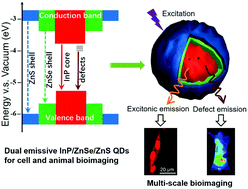InP/ZnSe/ZnS quantum dots with strong dual emissions: visible excitonic emission and near-infrared surface defect emission and their application in in vitro and in vivo bioimaging†
Abstract
Quantum dots (QDs) exhibit many unique optical properties, and show great promise as fluorescent markers in molecular, cellular and in vivo imaging. In this thematic issue, a major concern is their cytotoxicity. Among various Cd-free alternatives, InP-based QDs without highly toxic heavy metal elements have received the most attention. This article first focuses on the synthetic control of oil-soluble InP/ZnSe/ZnS QDs, exhibiting strong dual emissions, namely, visible excitonic emission and near-infrared (NIR) surface defect emission. Next, the organic-to-aqueous phase transfer of the dual emissive QDs was explored systematically. It was found that the dual emissions are relatively stable against the water transfer strategies used here; among them, aqueous dual emissive QDs obtained by wrapping oil-soluble QDs with a poly(acrylic acid)-octylamine (PAA-based) amphiphilic polymer (or modified with the cRGD peptide) exhibit enhanced NIR emission. Finally, using in vitro cell and in vivo small animal optical imaging techniques, the bioactivities of the cRGD-modified amphiphilic polymer-wrapped QDs were also investigated. The results confirm that single-wavelength excitation with strong dual emissions ranging from 550 to >1000 nm will endow the InP-based QDs with the capability for biomedical optical imaging across different spatial scales, as a promising alternative for Cd- and Pb-based QDs.

- This article is part of the themed collection: 2017 Journal of Materials Chemistry B HOT Papers


 Please wait while we load your content...
Please wait while we load your content...